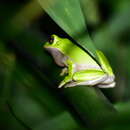Description
provided by AmphibiaWeb articles
Rhacophorus arvalis is a medium-sized tree frog, with male SVL of 39.9-46.4 mm and females 59.5-64.0 mm in SVL. It can be distinguished from congeners by the combination of a green supratympanic fold, uniformly green dorsum, white stripe on flank, white venter, skin flaps along forearm and tarsus that are narrowed and smoothed, forearm flap extending along the outer dege of the fourth finger, a prominent palmar tubercle, thigh that is uniformly pink, and pink foot webbing (Lue et al. 1995).Coloration in life: The dorsum can vary from dark green to nearly yellow. Supratympanic fold green. Upper lip is white; a single white stripe continues onto the flank. Flank below the white stripe is dark purple. Lower lip and edge of gular region are silver gray to white. Venter is grayish white while the infraanal region is white. Forelimb is green above and white below, with a white fold running along the outer edge from forearm to finger IV and a black stripe under the white fold. Fingers I and II pink on both dorsal and ventral surfaces. Fingers II and IV green (except pink tips) dorsally; Fingers III and IV pink on ventral surfaces. Hindlimb is green above, white below, with white fringe present from outer edge of tibiotarsal joint to tip of toe V. Thigh is dark pink on anterior and posterior margins; posterior thigh has a horizontal stripe that is particularly prominent behind the anus. Toes I-III are pink above and below. Toes IV and V are greenish dorsally, but gradually reddening toward tip. All toe tips are pink. Ventral surface of foot is pink. The iris yellow, with a black horizontal pupil. There is no sexual dimorphism in color pattern (Lue et al. 1995).The tadpole has a depressed body that is elliptical when viewed from above, with a weak lateral constriction. Dorsal surfaces are dark brown with irregularly-shaped black spotting. Ventral skin is silver-white except for the transparent midbody (Lue et al. 1995).First described by Lue et al. (1995). The species name arvalis is derived from the Latin word for agriculture and refers to the discovery of this frog in agricultural areas.This species has 2n = 26 chromosomes, consisting of five large and eight small pairs. Pair numbers 1, 4, 5, 6, 7, 8, 9, 11, and 12 are metacentric, while pair numbers 2, 3, 10, and 13 are submetacentric (Lue et al. 1995).
Lue, G. Y., Lai, J. S. and Chen, S. H. (1995). ''A new Rhacophorus (Anura: Rhacophoridae) from Taiwan.'' Journal of Herpetology, 29(3), 338-345.
Distribution and Habitat
provided by AmphibiaWeb articles
Endemic to Taiwan. This species occurs in the agricultural areas of Chiayi, Yunlin, and Tainin Counties in southwestern Taiwan below 1000 m asl. It is found in bamboo forests, as well as in orchards, sugar-cane fields, scrubland and cultivated fields (Stuart et al. 2008).
Life History, Abundance, Activity, and Special Behaviors
provided by AmphibiaWeb articles
Rhacophorus arvalis is nocturnal and is active during the rainy season, from mid-April to late August. During these rainy months, males are often found calling from lychee trees, mango trees, sugarcane, guava trees, pineapples, bamboo, and in rice paddies. The call is the simplest of all Taiwanese species of Rhacophorus, and consists of a single high-pitched note that sounds like "Dee". The fundamental frequency is about 2.5 kHz and the frequency is modulated, reaching maximum at 0.1 second and then fading away. Two to four harmonics are present, particularly at 5.0 and 7.6 kHz. The average call duration is 0.63 s, and average interval is 1.12 s (Lue et al. 1995).White foam nests are found in temporary ponds located in forests or adjacent to rice paddies, or in orchards. Nests contain between 104 to 311 eggs. Eggs are yellowish-white and measure 1.95 to 3.00 mm in diameter. Tadpoles metamorphose after 40 days on average (Lue et al. 1995; Stuart et al. 2008).Adults commonly consume blowflies (family Calliphoridae) (Lue et al. 1995).Predators include the Taiwan beauty snake (Elaphe taenirus) (Lue et al. 1995).
Life History, Abundance, Activity, and Special Behaviors
provided by AmphibiaWeb articles
This species is common but declining. It has only been found in disturbed areas that are used for agriculture. It is most threatened by road construction, industrial development, housing developments, prescribed burns in sugarcane fields, and agricultural pollution from pesticides (Lue et al. 1995; Stuart et al. 2008). Taipei Zoo and Taipei Zoological Foundation are working to conserve R. arvalis; although their first initiative to subsidize farmers growing bamboo did not succeed in maintaining frog habitat, new efforts are being made to preserve the habitat via support for ecotourism and a green-label certification system (Chang et al. 2008).
Relation to Humans
provided by AmphibiaWeb articles
It thrives in traditional agricultural lands (Lue et al. 1995), and is also found in the pet trade in central Taiwan (Hou et al. 2006).
Zhangixalus arvalis: Brief Summary
provided by wikipedia EN
Zhangixalus arvalis is a species of frog in the family Rhacophoridae. It is endemic to western and southwestern Taiwan and is present in agricultural areas of Chiayi, Yunlin, and Tainan Counties. Common name farmland green treefrog has been coined for it.
- license
- cc-by-sa-3.0
- copyright
- Wikipedia authors and editors

